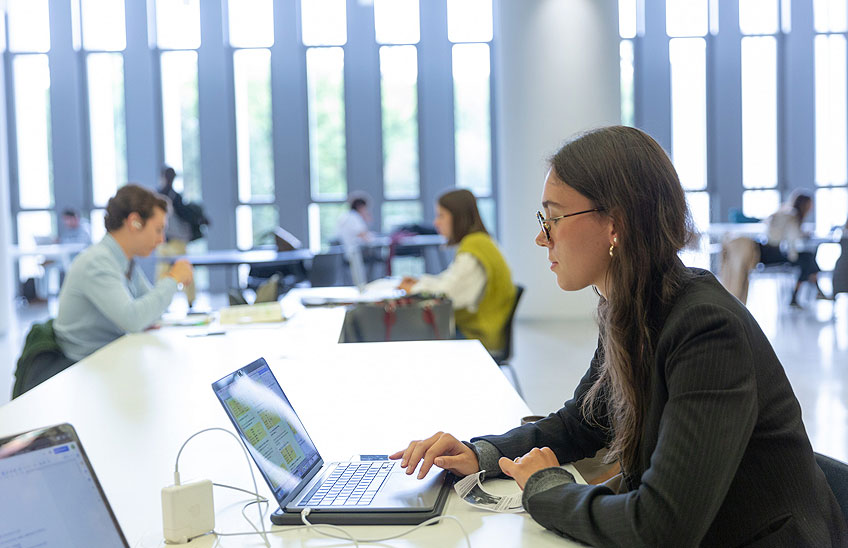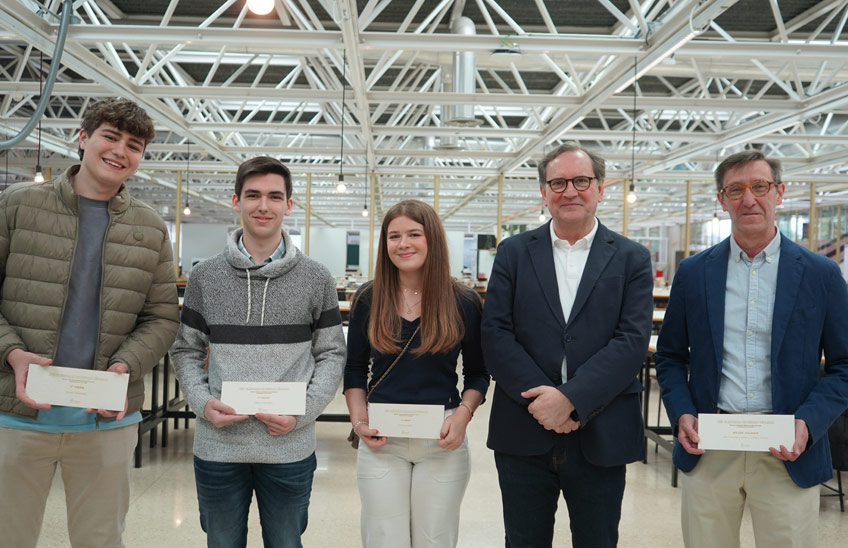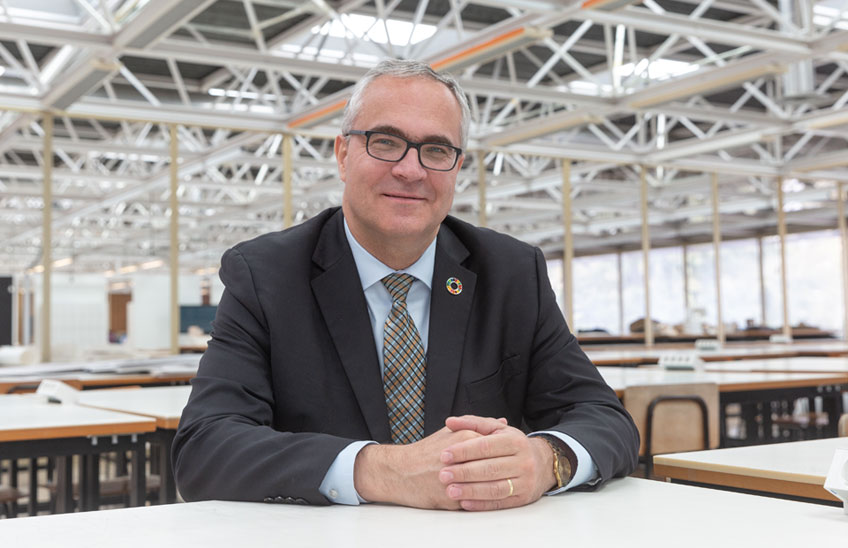The School of Architecture hosts the inauguration of the exhibition 'Cities and their thesis '.
The event took place on the occasion of the VII meeting of the research CITESIS Team.
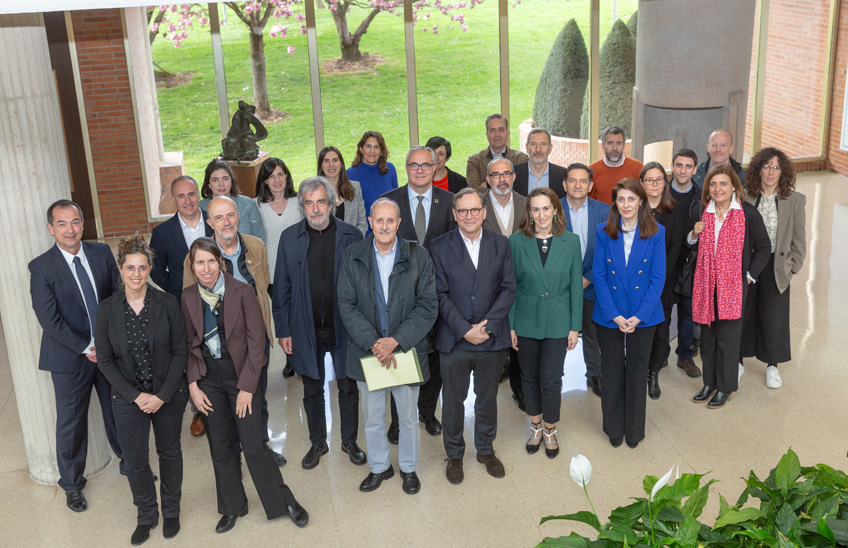
24 | 04 | 2024
On April 9, the inauguration of the exhibition 'Las ciudades y sus thesis ' took place on the occasion of the VII meeting of the research CITESIS Team at the School of Architecture of the University of Navarra, in Pamplona.
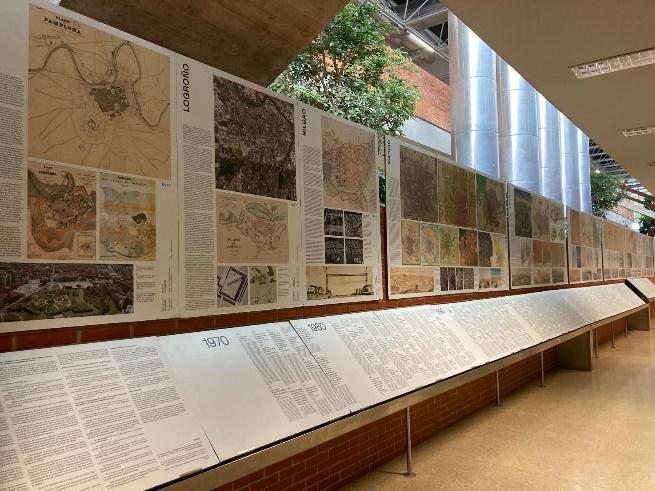 |
 |
Panels of eleven Spanish cities at the top and the chronology of thesis in the bottom row.
The traveling sample , which has already visited schools of architecture in Valencia, A Coruña, Madrid, Seville, San Sebastián and Zaragoza, includes a series of panels showing the urban development of eleven Spanish cities, a chronology of all the thesis carried out in the different schools of architecture during the period from 1970 to 2020 and a representation of these cities prepared by the 300,000 km/s studio. A video explaining the origin and description of the research was also projected to complement the panels.
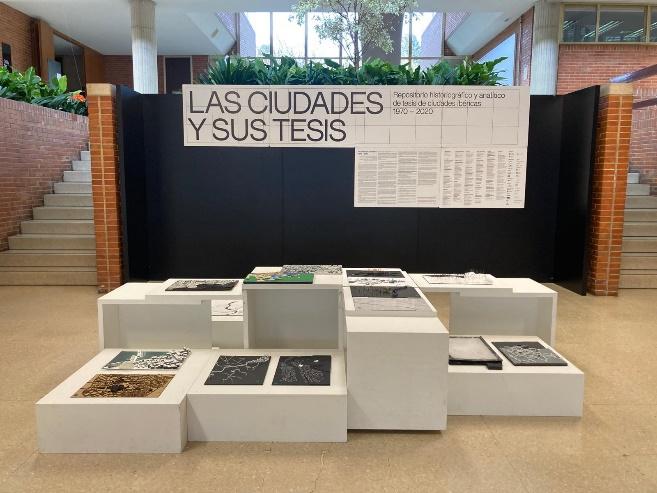 |
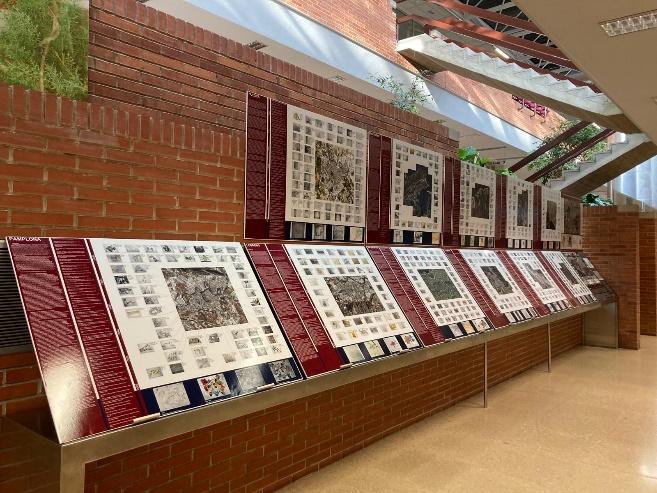 |
City models of the students of the subject Urban Morphology (2nd-GEA) and panels of thirteen Spanish cities from the project "La internship del design urbano en las capitales medias españolas (1950-2000)".
On the other hand, the University of Navarra's own School of Architecture incorporated its own material to the exhibition which exhibited, on the one hand, the urban planning of thirteen cities result of the project of research graduate "La internship del design urbano en las capitales medias españolas (1950-2000)" and eighteen models of Spanish cities prepared this academic year 2023-2024 by the students of the subject Urban Morphology.
The meeting, as has been the case on other occasions, has been a motive for a discussion on various issues raised by the exhibition. In the case of the School of Architecture of the University of Navarra, three papers were addressed; one of them of subject retrospective and two others of subject propositive.
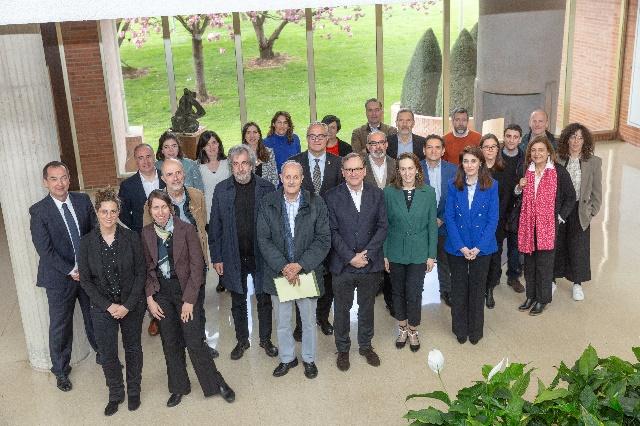 |
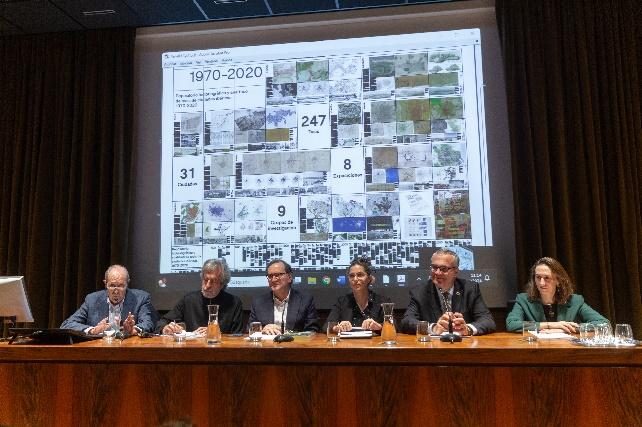 |
Photo of group and institutional inauguration (from left to right): José María Ordeig, Carles Llop, Carlos Naya, Maite Arrondo, Michal Mlynar and Maite Verdú.
The institutional inauguration was presided over by the director of the School of Architecture, Carlos Naya, who, after a few words of welcome, gave way to the explanation of the exhibition that was referred by Carles Llop, coordinator of the interdepartmental work. Maite Arrondo, Director General of Housing of the Government of Navarre, who, through the Nasuvinsa Society and the Chair of Territory and Housing, has supported the realization of this meeting, also took the floor at the opening ceremony.
Maite Verdú, Director General of diary Urban and Architecture of the Ministry of Housing and Urban diary (MIVAU), then spoke, encouraging the protocol signed between School of Architecture of the University of Navarra and MITMA in March 2023 to develop programs of study on diary Spanish Urban. Maite Verdú was accompanied by Michal Mlynár, interim executive director of UN-Habitat who presented the project Habitat-UNI encouraging to work in partnership with the University to face the urban challenges of the future.

Professor José María Ordeig, giving his discussion paper "Typomorphological considerations in the intermediate scale".
The first discussion paper was developed by José María Ordeig, who was a professor at School of Architecture of the University of Navarra. He dealt with the aforementioned project of research of medium-sized Spanish cities, which led to the preparation of panels, catalogs and thesis of fifteen cities. Based on the data compiled in these works, his intervention took the form of a retrospective view of the typomorphological phenomena of the most significant urban fabrics that occurred in the second half of the 20th century. Distinguishing two major periods separated by the decade of the 1970s, he showed numerous projects in which typomorphological similarity could be appreciated in very different contexts and cities, yet coinciding in time. This represented, for him, the formal response to the disciplinary speech that urbanism experienced in those periods which, although known by experts, was still interesting to see in the urbanistic internship of intermediate cities. He ended with an exhortation to focus on the positive aspects that these phenomena brought with them, instead of lamenting their mistakes.
 |
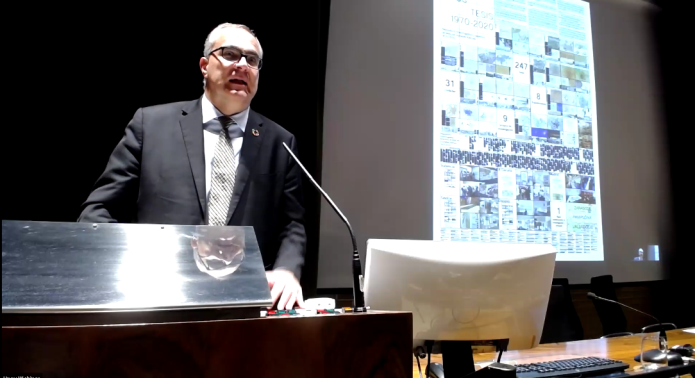 |
UN-Habitat's internal executive director , Michal Mlyár, speaking at the event.
The second discussion paper was at position by Michal Mlynár who, taking his cue from the partnership of UN-Habitat with the Spanish Ministry of Housing and Urban diary , presented an international vision of the current habitat problems in the world that affect undeveloped countries, but also developed countries that have serious pockets of poverty: homelessness, abandonment, etc. His exhibition, far from remaining a sterile criticism, encouraged to face challenges and take advantage of opportunities to solve these problems. The guidelines for tackling all this work were based on two convictions to be taken into account: first, to recognize that the problem is urban because it is a question of "housing", which is prior to other problems; and second, the importance of government intervention at all levels. Hence the importance of the Urban Agendas, of the knowledge provided by research in academic circles and of the synergies between various institutions.
Specifically, he presented the future creation of a global platform where the various actors involved in this issue would meet and which would be supported by the university institutions and which would have to crystallize into policy, from the European presidency to local administrations; a platform that would take advantage of the current IT possibilities to have a more complete view of current needs. He concluded by making reference letter to the possibility of creating action guides that would be a direct financial aid for users.

The Deputy Director General of Urban Policies of MIVAU, Sonia Hernández, giving her speech discussion paper "The Spanish Urban diary ".
Thenext intervention dealt with the Spanish Urban diary (AUE), its methodology and tools. It was at position by Sonia Hernández Partal, deputy director general of urban policies of the MIVAU, and guest professor of the School of Architecture of the University of Navarra. The AUE is a flexible and voluntary national urban policy, not compulsory, not imposed and above all adaptable to the evolution of the changing situations of the city, basically strategic. She commented on the ten general objectives of the diary, then focused on their implementation. For her, the objectives are achieved through action on rules and regulations, appropriately revised planning and funding. But to this must be added the exchange of knowledge and the training of young people who will be the technicians of the future, both in academic fields and in the fields of local administrations. Through participation, it is necessary to prioritize objectives and, above all, to achieve integrating projects that solve most of the problems that are required at the same time. Finally, he commented on how the implementation of the AUE has developed, from its beginning with two or three experiences several years ago to the present, in which there are already more than 300 cases in progress, which means a good reception for this methodology.

Professors Asier Santas Torres, José Ramón Bergasa and Elena Lacilla giving the discussion paper "El papel de la universidad en la implementación de la diary Urbana Española".
Closing these interventions, the third discussion paper referred to the role of the university in the implementation of the EUA. It was at position by Professors Asier Santas Torres, Elena Lacilla Larrodé and José Ramón Bergasa Pascual.
The first referred to the process that has been carried out at the School of Architecture of the University of Navarra on the programs of study of the AUE. Within one of the three mentions that the School offers to students, the accredited specialization in management of the project Urban bet on the signature of a protocol of the academic center with MITMA that, over time, has given rise to the 'Focused Course on Spanish Urban diary : the future of national urban policies', which has been taught during the months of February and March 2024 in online format with the financial aid of the Nasuvinsa Society and that precisely closed with this session.
Elena Lacilla, for her part, explained the work that has been carried out in these five years, under the agreement with the Ministry: the programs of study on real cases such as Bilbao, Barañain, Logroño, Encartaciones and Huesca. In these works, the methodology has been tested and adapted according to the areas studied. At the same time, a work of research has been developed, gathering in a 'Catalogue of good practices' about 60 cases of programs of study on the specific objectives of the AUE and other complementary works on specific aspects that gather the pilot projects of the Spanish Urban diary that have been the object of TFG and TFM, and that have given rise to several articles published in indexed magazines.
Finally, Bergasa, who is visiting professor of the School of Architecture (UNAV) and municipal technician, presented his unique experience in this synergy between the academic and the administrative, concluding that it is necessary to assess all the issues that transversely affect the city, but that perhaps the architect is one of the specialized technicians who could coordinate all aspects. He then explained the Course on diary Urbana that has been given during the months of February and March.
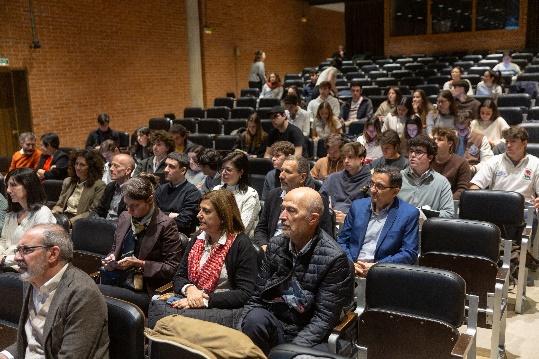 |
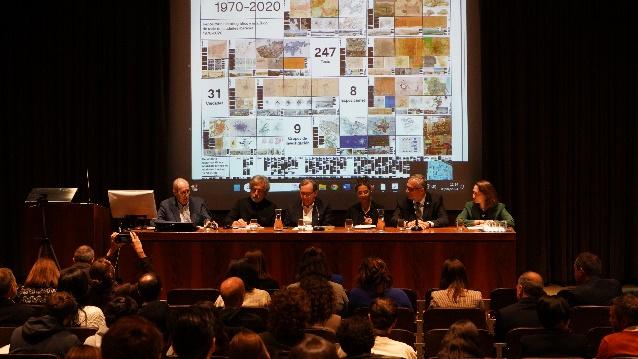 |
Speakers and audience at the classroom Magna of the School of Architecture of the University of Navarra during the workshop
Finally, a brief discussion was started among the attendees. In it, the network that has been formed with the Departments of Spanish Urbanism at purpose of the initiative of the "Cities and their thesis " was offered as a valid interlocutor before the possibilities of cooperation that Michal Mlynár offered in his speech.
The event was brought to a close with an aperitif, during which attendees and speakers were able to exchange experiences and opinions, as well as reflect on the development of past and future exhibitions.


